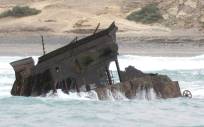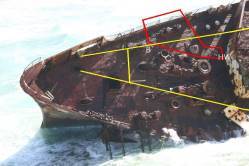"American Star" - An "Autopsy" by Sea ...
by Bill Lee
On January 18, 1994 a vintage vessel that had been under tow went hard aground in the Canary Islands, driven onto a rocky shore by a major storm. But this was not just another hapless vessel, but a one-of-a-kind ship with a long and rich history.
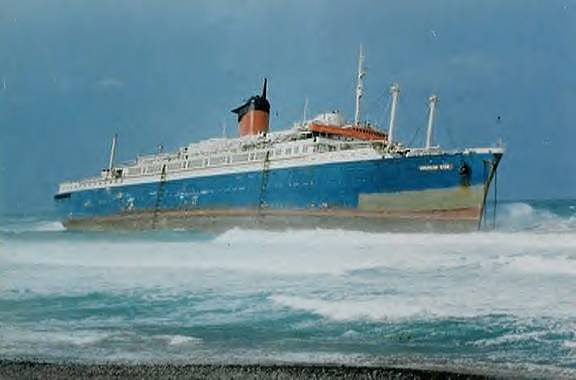 Designed
and constructed at the zenith of transatlantic passenger ship service
in the late 1930s, she was originally known worldwide as the
SS AMERICA - Queen of the American Merchant
Marine ...
Designed
and constructed at the zenith of transatlantic passenger ship service
in the late 1930s, she was originally known worldwide as the
SS AMERICA - Queen of the American Merchant
Marine ...
Abandoned, she was logically expected to break up and disappear in months, or, at most, in a year or two. But she resisted the ravages of the seas for far longer. This is the story of what happened after her life essentially ended, up to the point of near total destruction in the Spring of 2006.
What follows is a series of educated guesses, based on photos, the ship´s plans and known structural details, and observations by individuals who ventured onboard before wind and wave made that always-dangerous adventure too risky.
Even today, over twelve years after going aground, what still remains stands as a tribute to her shipbuilders who so often used an archaic phrase to describe the strengths they applied to their seaworthy creations - built hell for stout ...
Optimistically renamed AMERICAN STAR, she was under tow to Thailand to begin another chapter in her life when the towline, her lifeline, snapped. Recovery efforts proved fruitless. A strong storm tide carried the vessel hard aground in January of 1994.
At first, it appeared to curious onlookers that she could be safely refloated when the storm subsided. But hurricane-strength winds and mountainous waves continued to pound the hapless hulk, turning her almost broadside to the unrelenting sea. With one end fatally pinned to the rocky shore, and the other afloat, her hull was flexed unmercifully for almost 48 hours. Finally, her hull and superstructure - over 55 years since first being riveted together - suffered a total fracture; the result of metal fatigue. This catastrophic failure broke the vessel´s back, ending all practical thoughts for salvage of the vessel ...
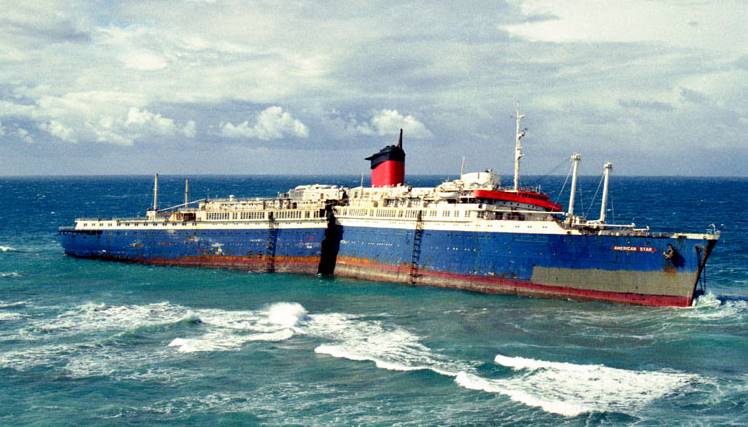
She separated just aft of the athwartship watertight bulkhead that normally had isolated the engine room from the aft boiler room. The break occurred roughly at Frame 140, just behind her remaining funnel. Ironically, this is almost the exact same location where her deck plans and inboard profile were separated to facilitate a two-page spread for publication in 1940, the year of her completion ...
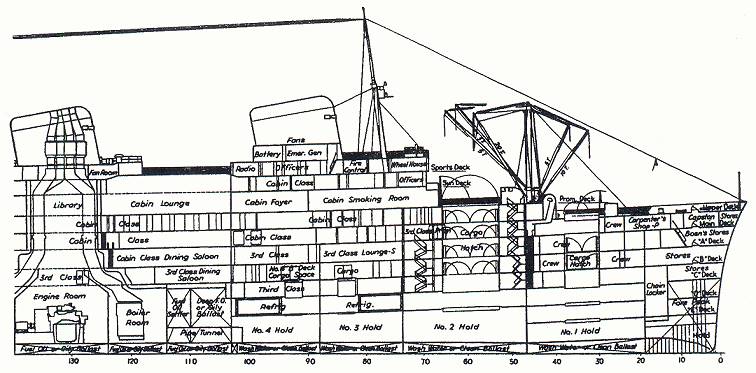
Still afloat in deeper waters, the severed stern section rotated slightly to starboard, with respect to the forward section, towards the shore. Two years after grounding, and aided by progressive and uneven flooding, the stern section rolled over and sank. Structural extensions added aft in 1964 to her Upper, Promenade and Sun Decks very likely contributed to an unstable condition that resulted in the loss of that portion of the ship. In addition, the vessel´s compartmentalization probably had just the opposite effect of what the designers intended, and helped contribute to the eventual demise of the stern section ...
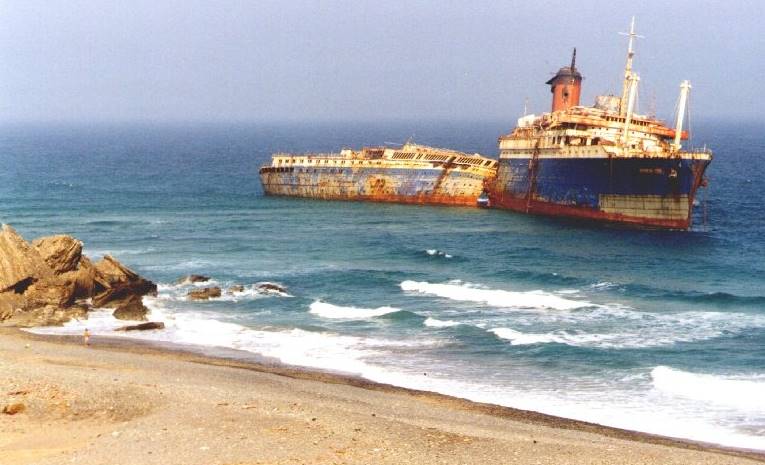
The introduction of the sea into that fractured half probably progressed, deck by deck, especially during subsequent storms. Once the ocean had gained entry to C Deck and possibly the decks above, the many marinite bulkheads (and some relatively thin steel ones, as well) would have become easily breached. As a result, water penetrated into these areas and flowed by gravity to her low (port) side; to remain there, in large part, trapped by debris.
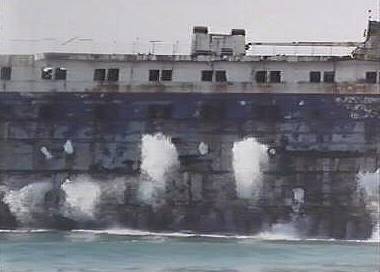 That
alone, coupled with the mass of structure previously added to her Upper
and Promenade Decks well aft, would have created a dangerous top-heavy
condition for the stern section after it had broken completely free
of the forward section.
That
alone, coupled with the mass of structure previously added to her Upper
and Promenade Decks well aft, would have created a dangerous top-heavy
condition for the stern section after it had broken completely free
of the forward section.
In addition, portholes must have sprung leaks, or been smashed by pounding seas on the port side. Scavengers removed many of the brass porthole frames, with their heavy glass, from both sides of the vessel, and reused ashore. Water obviously accumulated several feet deep on C Deck, as the photograph on the right side indicates. The curious result, when seas pounded the stern section, was for water to sprout out of the starboard side open ports.
Aft, on both D and Hold Decks (see partial deck plans, below), the ship´s design featured numerous tanks that normally contained liquids. These tanks were probably deliberately empty when the ship went aground, to help reduce resistance during towing. In addition, the fuel oil settling tanks would likely have long before been pumped out (to recover valuable fuel oil).
Some of the other tanks could have been pumped dry as well - to help keep her from sinking in a Greek harbor when a pipe burst in the unattended engine room that caused considerable flooding in that space before being discovered and rectified. All of which would have further contributed to a decidedly unstable condition ...
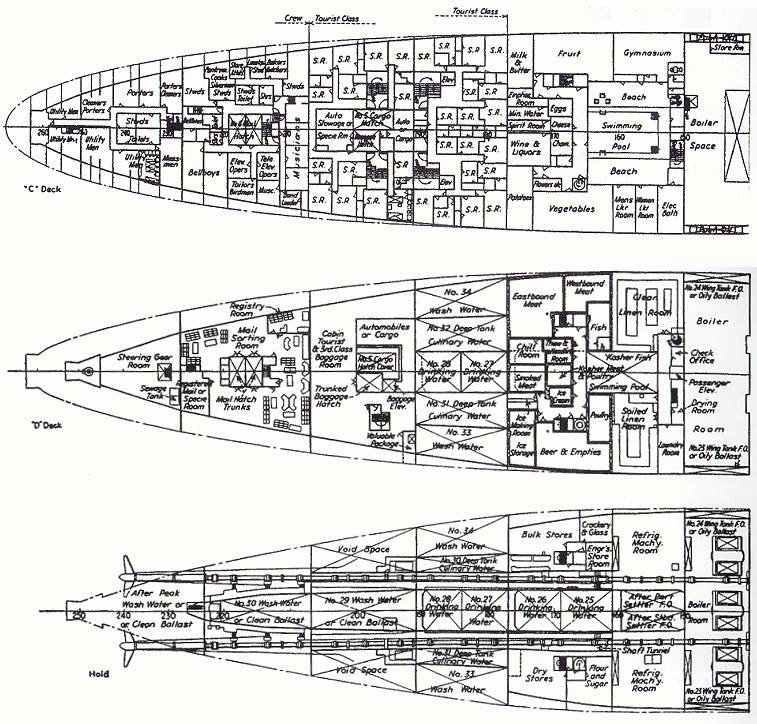
Flooding of these tanks from beneath was very unlikely, since the ship´s design included a complete double bottom structure and that part of the ship apparently never went aground. Also, even if the shell plating in this area had been damaged, the innerbottom structure would have most likely protected some - if not all - of the tanks located on the two decks immediately above. Plus, the bottom plating at the stern rises sharply, away from the rudder and propeller area, and so there was very little structure available there which could provide any stability at all for the severed stern section. Lastly, there is every indication that the water was far too deep under the stern section for any such support to ever have been possible.
Inspecting available pictures, it also appears some of the stern section´s port side super structure later gave way to the force of the sea, or was unable to stay in proper alignment when the stern section started to roll to port. This was due, perhaps, in large part, to the resultant mass of weight suspended to port. This condition was more pronounced in the areas extensively modified and inadvertently made top heavy, and would have very likely contributed to the relatively rapid capsizing of the stern section. The unaltered portions of her hull closer to the extreme stern appeared to resist such forces, up to the very end.
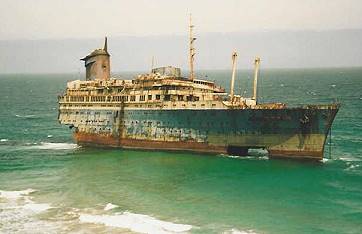 That
end came in 1996, when the stern section rolled to port and disappeared.
That
end came in 1996, when the stern section rolled to port and disappeared.
Meanwhile, her more imposing forward section survived, seemingly unfazed by the sea´s relentless attacks. The ship´s stout hull and equally strong supporting structures were riveted together, and to took years for Mother Nature to pry away pieces. But pry she did, first tearing away hull plating nearest the point of hull fracture. Still, eight years after grounding and despite storms, looting and lack of human care; the forward section was still largely there.
But these remains were clearly showing signs of superficial deterioration - to be expected by any unkempt metallic object exposed for so long to such a harsh marine environment. More ominously, a considerable amount of shell plating under the funnel had disappeared into the sea, leaving the funnel and several upper decks seemingly unsupported.
In addition, as the overlay of her midships area clearly indicates (see overlay on the left below), the relatively uniform break in her hull at Frame 140 that had left her engine and forward boiler rooms seemingly intact, initially, had been replaced by an ugly, ragged tear. At some point between 1994 and the turn of the century, a storm (or storms) apparently had ripped away her massive twin engines, her trio of forward boilers, and all that was associated with them, including large portions of inner bottom and side tankerage structures ...
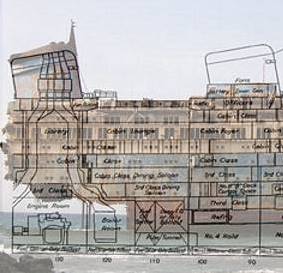 |
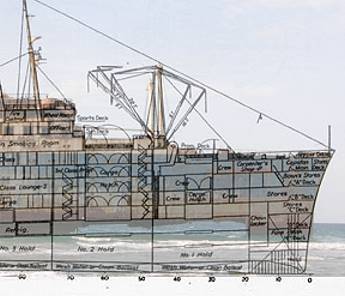 |
Further forward (see above overlay on the right), a small amount of hull plating and associated backing structure was first noted missing in way of the #1 Cargo Hold. Over time, this so-called "bow hole" became significantly elongated, ultimately extending to the full length of Cargo Holds #1 and #2. This deterioration took place at the waterline, and it eventually resulted in the loss of lower portions of the transverse bulkhead about Frame 48, but did not impair the structural integrity of her upper hull, as evidenced by the forward king posts remaining in alignment.
This additional sign of physical distress caused numerous people to speculate in 2002 that her ultimate end was near. But that did not start to happen for almost four more years.

In fact, with these large spaces opened to the sea, the punishing effect of crashing waves on the port side were mitigated somewhat by the ability of water to flow freely and transversely through this opening. Less visible, to those who viewed the wreck from the beach, was a much more significant loss of plating, all along the port side´s waterline. Ultimately, this condition led to a dramatic change in the wreck´s condition in later years.
By 2002, the gap (at the water´s edge) under her funnel began to appear more ominous. Her boiler uptakes, as shown on the inboard profile, came together above the engines on their way to the stack. With the stern section gone, much of the area where the aft boiler room uptakes once were located became fully exposed to the elements.
The uptakes were relatively lightweight steel, and not sized or supported - or ever intended - to take on the full impact of the sea. They apparently did not survive for long, as they most likely became quickly mangled and torn away. With her entire mid ship´s cross section totally exposed to the elements, and facing towards the open sea, the interiors of the several decks located forward of the initial break point undoubtedly suffered greatly from the cumulative effects of wind and wave.
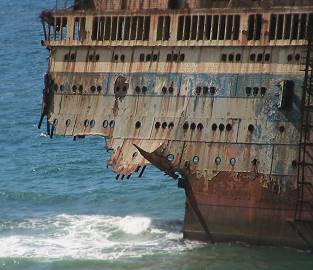 |
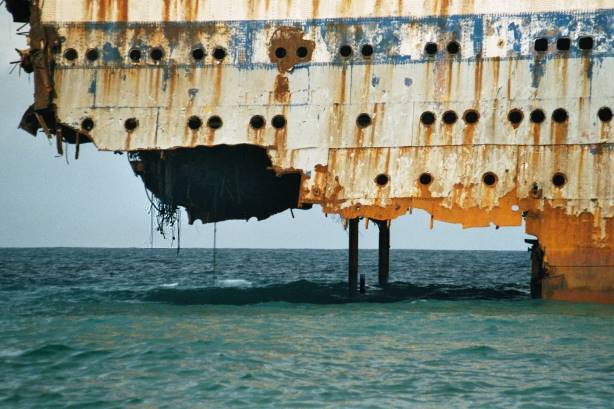 |
The pattern of portholes visible in close-up photographs taken then indicate that staterooms in this area (on B Deck, forward) and most, if not all, of the main dining room (on A Deck) were still structurally intact (see above photograph on the left). But their interiors had almost certainly been ruined by exposure to the elements by then.
The open hatch (on Main Deck) seen in this photograph was apparently left in that position by people visiting the wreck.
Another photo, taken from a slightly different angle, reveals two stanchions that once supported machinery auxiliaries in the upper, forward portion of the engine room (see above photograph on the right). The mass of severed cables hanging down once connected the main switchboard (located amidships and aft in the engine room) to an electrical load center on B Deck, which was located on the starboard, inboard side of the ship´s main fore-and-aft passageway on that level.
By 2003, a full view from starboard was even more telling. The next photo shows that the loss of hull plating on the starboard side had migrated from the original break point (approximately Frame 140) forward to the transverse bulkhead at Frame 114. This critical structure, a watertight bulkhead that separated the forward boiler room from other parts of ship in the bow, was located over 70 feet from the point of the initial break.
As a result, portions of the hull and superstructure, and the ship´s funnel, positioned immediately above where the engine room once was located, appeared unsupported. It was probably the very strong, web-like structures that formed the hull at the Main and Upper Decks (i.e., the top of the theoretical structural "beam") that kept the funnel standing tall and proud for so long. Credit the designers, who created a stout structure to resist winter storm weather in the North Atlantic. Further forward, a main transverse support left intact was the watertight bulkhead at Frame 74 (see inboard profile). Importantly, it was directly under and provided major support to the bridge area ...
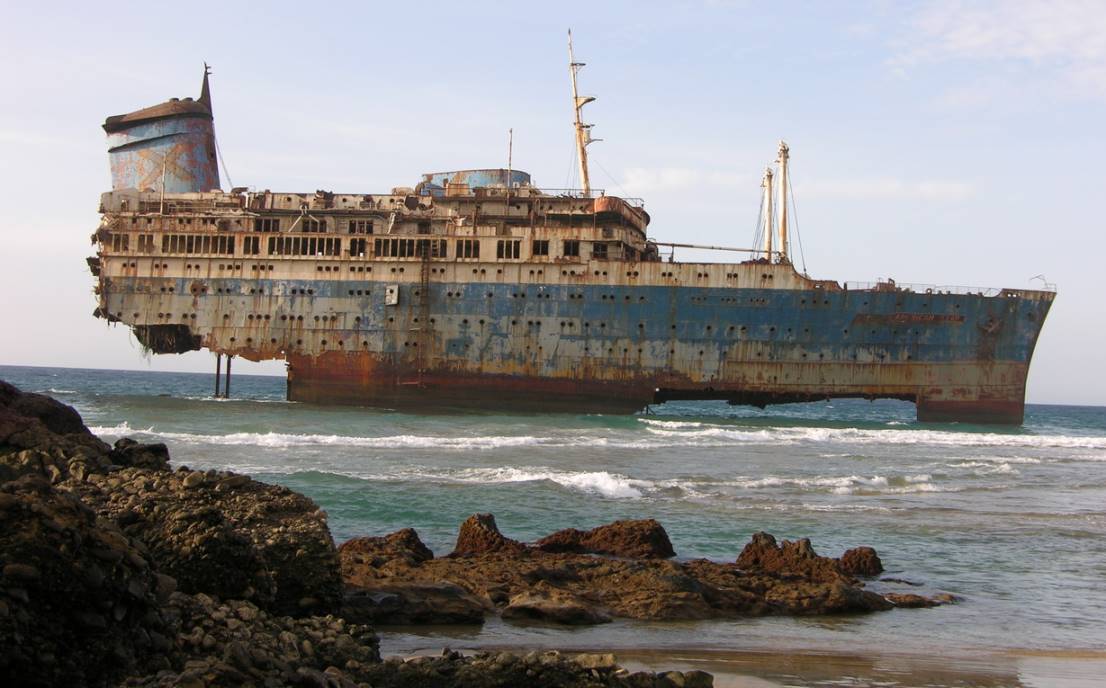
Amongst the layers of paint that blasted away by the elements was the red coating applied to the funnel before the ill-fated tow commenced. In the image above, some blue paint from her last period of service is visible, along with the outline of a big "X", which stands for the Greek letter "Ch" in "Chandris".
Although mast and kingpost rigging had to have lost some strength, over the years, the foremast and the forward set of king posts remained stubbornly in place. Not visible in this image is one of two propellers, still in place on the vessel´s foredeck. Removed from their shafts to reduce drag during the tow, they obviously were too heavy for the sea to claim them. Also too heavy, apparently, for the limited skills of the islanders. One of the propellers fell into the sea because of undersized lifting gear being used by someone attempting to remove it and sell for scrap ...
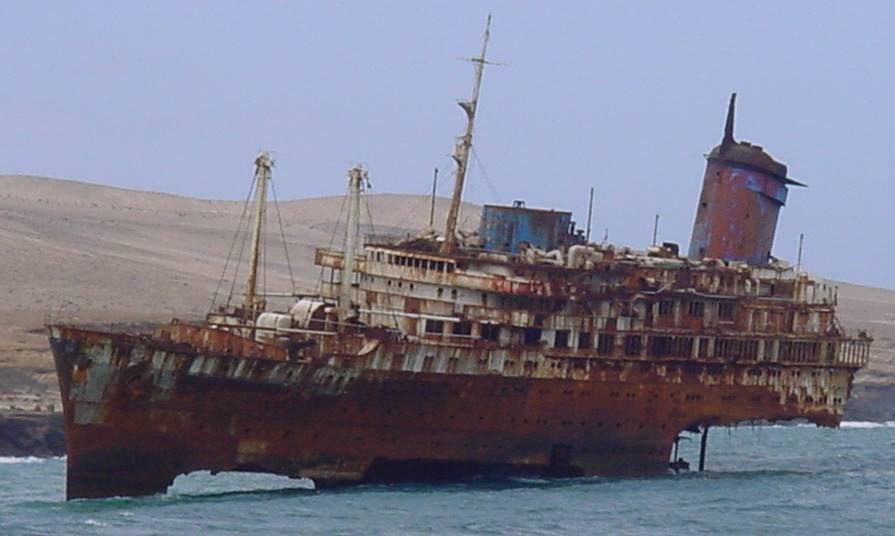
As the years went by, the forward section of the wreck - especially on the windward, i.e. the port side - began to display troubling images of much more significant structural deterioration. By mid 2005, a view of the wreck indicated that there was very little structure left on the port side to support the mass and weight of the structure that had maintained a constant five-degree port list for almost a dozen years.
Not only was much of the hull plating on the port side already gone when the "bow-on" photo was taken (see photograph on the left below), so, too (most significantly), were all of the transverse bulkheads on that side, as well as the port side wing tanks of the forward boiler room.
Simply put, all of the vertical support for the wreck´s remains, by that time, were essentially limited to structures to starboard of the vessel´s centerline, resting on rocky shoals.
Furthermore, a part of the starboard side plating, beneath the precariously overhanging structure then still supporting the funnel, was noted to have been forced out of position; sticking up at a severe angle. This may have been due to the force of a fierce storm, or extreme stress on that side may have caused the deformation.
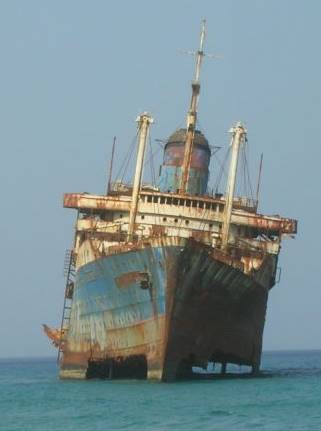 |
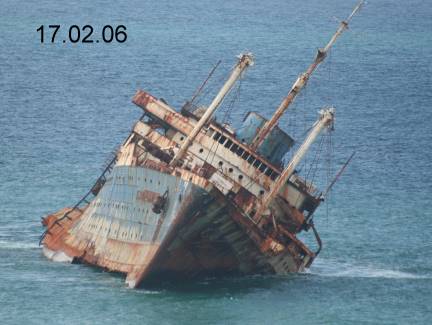 |
To even the most casual of observers, the forces that caused such additional damage were clearly beyond the wreck´s ability to resist much longer.
In the Fall of 2005, one of the many storms her rudderless remains could no longer turn to face caused the port side hull structure to experience catastrophic collapse. Internally, the ship´s structures in the vicinity of B, C and D Decks - and particularly on the port side - undoubtedly were badly deformed, perhaps totally collapsed. Externally, the wreck's profile was markedly changed, when the aft funnel was reportedly lost to the sea sometime between 13 and 15 November 2005.
Although this caused the wreck´s center of gravity to move to some unknown point well to port of the vessel´s centerline, the rocky ocean bottom beneath apparently kept the mass from totally rolling over (see above photograph on the right).
Some stability, even in this extreme positioning of the hull, was the result. However, in turn, this dynamic shifting of weight must have put sudden stress on her starboard side hull plating, causing it to fail and bulge far out in the vicinity of the midships break. In addition, the wreck appears to have taken a slightly more severe trim aft, which may have also contributed to significant structural distortion on the starboard side at the waterline.
The result was a drastic and irreversible change in her appearance. The wreck assumed a list to port of about 30 degrees, allowing the sea to directly attack the superstructure on the port side because of this precarious position ...
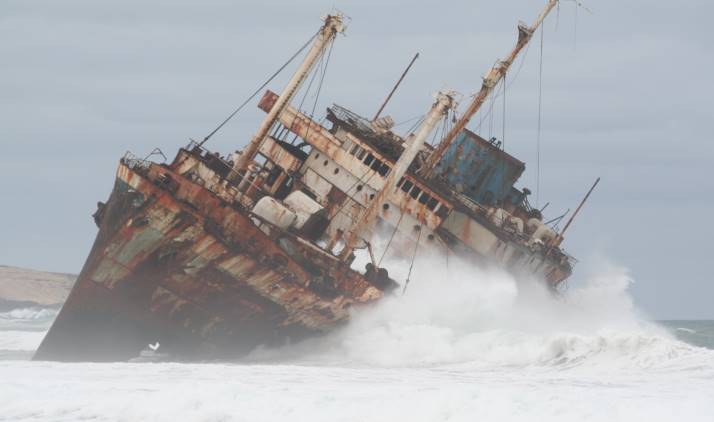
Within weeks, after her port side´s relatively lightweight superstructure had been directly exposed to destructive wave action, it also collapsed. Without that all-important measure of support, her remaining signature smokestack disappeared forever into the sea, along with her port bridge wing and large portions of the Sun and Promenade Decks. Much of the starboard side superstructure that then remained, and had resisted the elements for so long, became but a facade. Less than a third of the original ship remained, at that point.
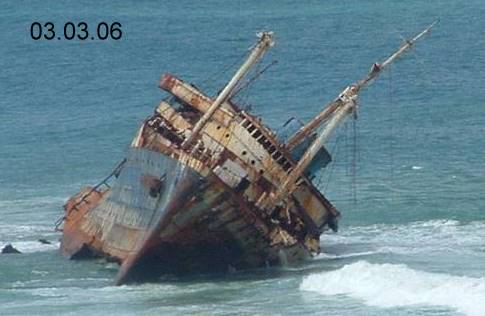 Her
starboard side remained firmly pinned to the rocky shore by her remaining
tonnage and, perhaps, also because she had originally been driven so
far ashore. By early March 2006, the sea´s force has caused the remaining
portions of the Promenade and Sun Decks on the port side to truncate,
resulting in the bridge, forward funnel stub and foremast to take on
a list of some forty degrees.
Her
starboard side remained firmly pinned to the rocky shore by her remaining
tonnage and, perhaps, also because she had originally been driven so
far ashore. By early March 2006, the sea´s force has caused the remaining
portions of the Promenade and Sun Decks on the port side to truncate,
resulting in the bridge, forward funnel stub and foremast to take on
a list of some forty degrees.
In addition, the hull plating on her starboard side shows even more distortion, as well as some additional wreckage appearing in the ocean nearby. All this dismemberment also resulted in a profusion of materials being cast up on the beach.
Eventually, perhaps very soon, additional storms will likely complete this autopsy by sea that has now lasted for over twelve years; sending her visible remains beneath the waves to rest and reunite with all the other portions of this once-mighty vessel once and for all.
And forever.
And the unrelenting sea will then continue to wash over her grave ...
Bill Lee
March 2006
1st Appendix, April 2006: Only a few weeks later ...
The new pictures of Matt & Sandy Barker show much more damage in bridge area, foremast is completely gone, and the area beneath the forward funnel stub has been washed away. Can´t tell for sure, but it appears that propeller which has been resting on the foredeck since before the tow began has now tumbled into the sea (perhaps because the wreck is listing even further to port - can´t be sure). Certainly, the bridge and forward funnel base are listed more that way than the rest of what remains. I think the weight of the emergency diesel generator and batteries in the forward funnel base will soon cause that to fall as well.
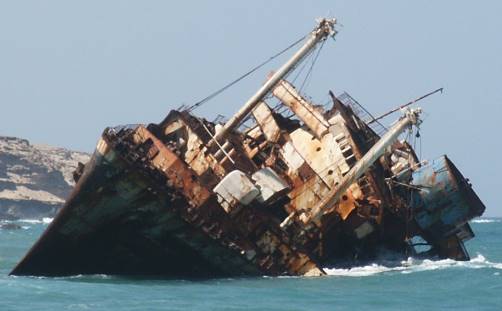 |
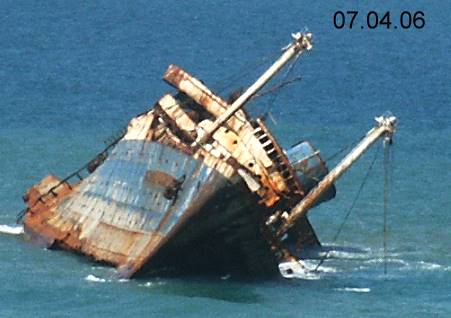 |
The pictures were taken at the beginning of April 2006. I have calculated that the wreck has apparently rolled even further to port (hull is now listing at an astounding 45 degrees). As a result, the vessel´s Upper Deck, which normally is about 40 feet above the water's level, is now right at sea level - on the port side.
In addition, and most significantly, waves can now directly attack the port side superstructure, and - as a recent result - the bridge structure is obviously falling apart rapidly, and the forward funnel stub - is leaning even further to port. Hard to calculate, but I think its leaning as much as 55 degrees, and may disappear soon. Very soon ...
2nd Appendix, March 2007: The remains suffered accelerated damage
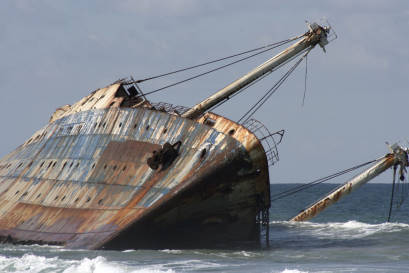 Throughout 2006, and into the first quarter of 2007, the remains
of the AMERICAN STAR suffered accelerated damage, as the sea methodically
swallowed up great chucks of her superstructure, and tore away shocking
amounts of her once-sturdy hull.
Throughout 2006, and into the first quarter of 2007, the remains
of the AMERICAN STAR suffered accelerated damage, as the sea methodically
swallowed up great chucks of her superstructure, and tore away shocking
amounts of her once-sturdy hull.
In addition, major structural losses on her port side resulted in a further increase in list - now estimated to be about 55 degrees - making it impossible for anyone foolhardy enough to go onboard the remains to stand erect.
Nevertheless, in tribute to her designers and constructors, her forward king posts still remain in place, even though some of their rigging supports have failed.
The reduction in her remaining mass has allowed storm waves to repeatedly wash over and into her innermost spaces. Only her once-proud bow appears relatively undamaged; pointing at the nearby shore in an attitude never experienced in all her years of service.
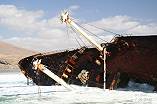 Both
of her forward cargo holds are now open to the sea; not only at the
bottoms of these spaces, but also above, since their hatch covers have
succumbed to the sea's relentless pounding. Many of her forecastle deck
fittings have disappeared, and one of her cargo winches has come completely
free from its foundation; simply waiting for the next storm or two to
carry it from sight, as well.
Both
of her forward cargo holds are now open to the sea; not only at the
bottoms of these spaces, but also above, since their hatch covers have
succumbed to the sea's relentless pounding. Many of her forecastle deck
fittings have disappeared, and one of her cargo winches has come completely
free from its foundation; simply waiting for the next storm or two to
carry it from sight, as well.
The greatest apparent change, to those who have watched her slow demise over the thirteen years that have passed since she went aground, is the complete disappearance of her entire superstructure. Everything above the Upper Deck is now gone.
This next image graphically illustrates the physical losses that have occurred, since she broke in half. A great deal has changed in the last year. Everything in the area outlined in red is now gone. What is left only remains because her Upper Deck was designed to be the top of her structural hull. The lighter weight steel above that point could not resist the strength of the open sea, once directly exposed.
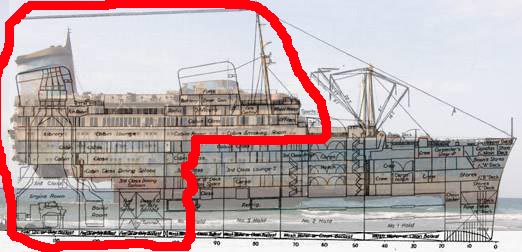
The break amidships that exposed her innermost areas has resulted in a progressive tearing away of about 40% of the remaining forward half of the ship. Undoubtedly, what remains has been destroyed, internally, and only the weakened shell of the ship is left.
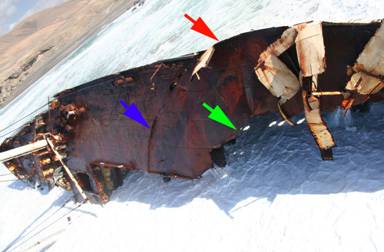 As
the photo on the right reveals, significant damage has occurred to the
shell plating and decks in the forward area of the Promenade Deck. Some
of this structural loss undoubtedly has been in progress for years;
but was not visible until the superstructure was torn completely away.
The loss of all structure above the Promenade Deck's plating was most
likely accelerated by this situation.
As
the photo on the right reveals, significant damage has occurred to the
shell plating and decks in the forward area of the Promenade Deck. Some
of this structural loss undoubtedly has been in progress for years;
but was not visible until the superstructure was torn completely away.
The loss of all structure above the Promenade Deck's plating was most
likely accelerated by this situation.
The green arrow indicates how far, both forward and to starboard, the structural loss has extended. Obviously, little is left below - note sun light shining through from a few remaining starboard side portholes, below. The blue arrow indicates where the base of the forward, curved bulkhead on this deck was located, and the red arrow points to a fragment of the ship's superstructure; torn and tattered and vulnerable to the next storm.
As the image below illustrates, because so much of her port side plating and decks in that vicinity have now been claimed by Mother Nature, the starboard side has collapsed inwards, to some extent. In addition at least one large section has broken free and now lies closer to the beach, alongside the main body of the wreck.
How much longer until no recognizable signs of the AMERICAN STAR remain is anyone's guess. The most likely scenario is for the bow to roll completely to port, to some final resting position, with the hull eventually collapsing into an undistinguishable heap of rusting metal, and the king posts finally coming free to disappear into the sea.
Because of the shallow water where the bow section ended up, it probably will be decades before all signs of this once-proud ship completely disappear from human view. Until then, what may well mark the site of her demise will be a grim 'grave marker' of sorts consisting of her tortured remains ...
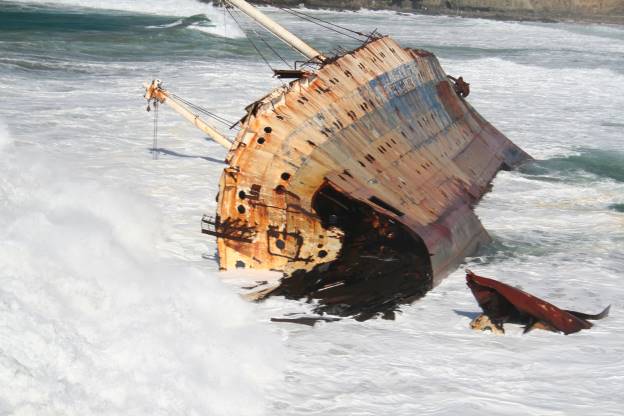
3rd Appendix, April 2007: The Final End is Near
Approximately 20 March 2007, another storm hit the remains broadside. In a video taken at the height of the storm, the bow (and especially the one remaining kingpost) can be seen moving up and down slightly as the storm tide caused the bow section (greatly reduced in weight by last year's storm damage) briefly floated the remains.
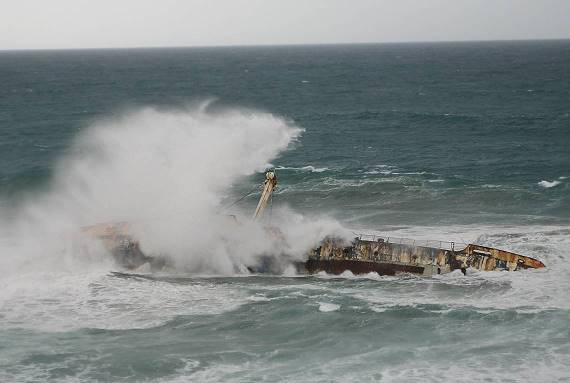
When the most recent heavy weather event had subsided, the bow section was left broken into three distinct pieces and rotated, slightly, towards the open sea. The port kingpost has been ripped free, and the wreck's remains are now almost on its beam ends.
This most recent and major destruction is the apparent result of the long, linear openings created by the sea along the waterline in way of the two forward cargo holds, and the greatly weakened condition of the ship's port side hull plating and interior support structures - exposed to the ravages of the sea for over thirteen years ...
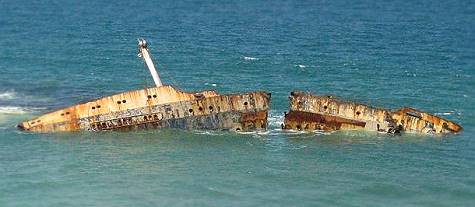 |
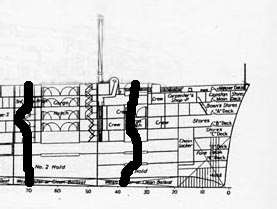 |
Here's a scale drawing of what's currently left that is at least partly visible in calm seas, with the most recent rupture points indicated by two heavy vertical lines.
Apparently, before it broke into three pieces, the bow tried to escape to deeper water and erase all of the sad memories of this once-proud passenger liner. Another storm or two should end its trails, for once and for all.
4th Appendix, January 2008: The Destruction Accelerates Again
Since the spring of 2007, what little remains of the AMERICAN STAR has gone through a series of further and significant changes. The following images were captured in September, November and December of 2007, respectively.
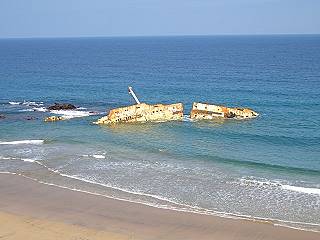 |
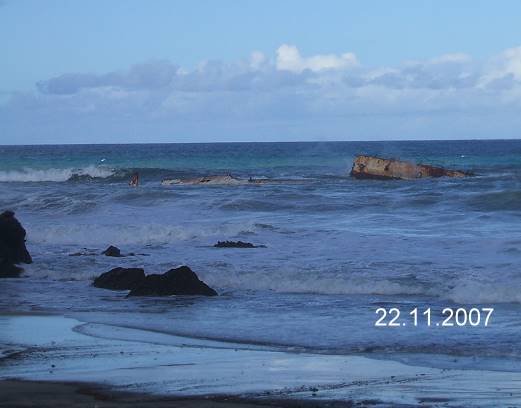 |
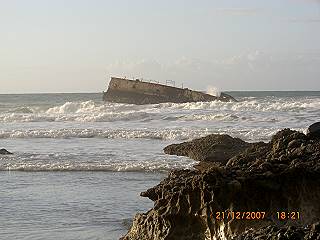 |
The hull section supporting the last surviving king post evidently collapsed before, or at the same time that this section of the broken bow disappeared from view. That change was first seen on the morning of 22 November 2007, and was undoubtedly due to the unremitting onslaught of wave action to the severely damaged structure. Other portions of the wreck, albeit unrecognizable, appear and disappear according to the whims of wind and tide.
The very tip of the bow, which now measures approximately 65 feet long (less than 10% of the ship's original length of 723 feet), is all that currently remains visible. Apparently, the ship's anchors are still attached, held securely by very rusted, yet still very strong chains; causing the ship's last visible remains to seemingly 'bow down' to the elements. In a final, futile effort to break free, this small section of the ship's hull may have actually floated free of the grip of the rocky shore, moved closer to the shoreline and perhaps some distance to the right (as viewed from the shore). Efforts are currently underway to confirm this suspicion.
The winter storms of 2007/2008 will likely remove even that last remaining reminder of the beautiful ship of which it was once such an important part; parting the waves over decades of travel in peace and in war that covered over 4.9 million nautical miles ...
5th-6th Appendix, April/June 2010: Finality Delayed
THIS STOUT SHIP’S LAST VISIBLE REMAINS STILL DEFY MOTHER NATURE
Over the past three years, storms have still not been able to complete the dismemberment of this once-proud ocean liner. The photograph on the right below was taken on 8 March 2010.
The portion of the ship’s bow that still resists destruction, over 16 years since the ship went aground is shown here, outlined in red. This photograph on the right below was taken on 24 February 2007.
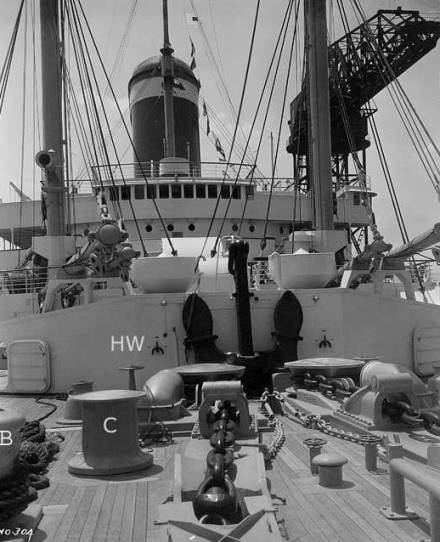 |
|
The two photos provided above include three distinctive items: a large double bitt (B) that was positioned on the starboard side of the vessel’s foredeck, a capstan (C) for line handling and a hand wheel (HW) that once controlled the brake on the starboard anchor’s chain.
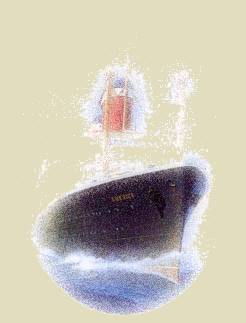 The
photograph on the left above, taken when the ship was completed in July
of 1940 has been marked up to indicate the original and never-changed
positions of these items. The photographer´s view is shown on the right,
outlined in yellow by reader and photodesigner René Schreckenberger.
The
photograph on the left above, taken when the ship was completed in July
of 1940 has been marked up to indicate the original and never-changed
positions of these items. The photographer´s view is shown on the right,
outlined in yellow by reader and photodesigner René Schreckenberger.
How much longer these sturdy components of marine hardware will resist the elements is anybody’s guess ...
Rest in peace, AMERICAN STAR!
© Text/Photographs 2006-2010 Bill Lee; additional Photographs by Steve Mulliss, Explorer Magazin and Readers Sigurd Brauer, Ferdi Müller, Alex Barczyk, Jan Liska, Oliver Heinrich, Friedrich Föste, Herbert Edelhoff, Thomas Tamme, Matt & Sandy Barker, Jens Schröer, Jürgen Wrusch, Familie Höfer, Peter Schmolke, Petra Südkamp, Dr. Christian Bujack
